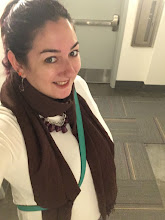This morning I read the first chapter in The 7 Habits of Highly Effective Teens
by Sean Coveny. The main ideas I took away from that first chapter are
things that need to be taught before you start teaching the Habits to
your students.
Firstly, they need to know what a Habit is. Luckily for me, we already had a team at school develop a lesson for that. Check!
Secondly, they need to know what a Paradigm is. I added this to my to-do list.
Third,
they need to know what Principles are. I have few self-reflective
quizzes from various places about learning styles, values, and
principles, so I will incorporate these into the first month of school.
Then I will use an idea from Mr. Richards' class
and have students create their own personal Mind Maps. It will be their
first assignment. Last year, I had the I Am Poem be their first
assignment. The way I've laid out my first month of school, I think that
will be the second assignment. Mind Maps are easier for students who
aren't as good with words, such as visual and kinesthetic students.
Then
I got excited about what else I could integrate with this, like stories
from the Chicken Soup for the Teenage Soul series, and needed to remind
myself to slow down. So I picked up the best book ever given to me, and
started at the beginning.
My master teacher, during my student teaching at a junior high, gave me this book. Teaching Outside the Box (How to Grad Your Students By Their Brains)
by LouAnne Johnson. I'd already read thoroughly the first three
chapters, and had skimmed the fourth. But it's the fourth that I needed
to re-read today. "Make the First Week of Class a First-Class Week." I
skimmed the second and third chapters as a refresher, then delved into
the fourth, complete with highlighters, pens in multicolors, and sticky
notes. Now, if you know me well, you know I have an aversion to writing
in books, even text books. But for teaching books, I've learned to make
an exception. It is highly important to highlight key phrases to
remember, and to make sidenotes about connections to other books,
teachers, procedures, as you are reading. The sticky notes are to mark
pages that I need to look at again. I prefer bright and bold colors, and
so I use them.
After reading chapter four, I went to work. I printed out a month
by month calendar for next school year. I was highly impressed by the
Mac's calendar program. I was able to print out a years' worth of
months, correctly labeled, and with the calendar notes I chose, in one
easy screen. And to top it off, securing my pleasure in the program, it
printed collated. Yay!
Then, following the directions in Out of the Box I went
through and color-coded highlighted days off, teacher work days, ends of
grading periods, and minimum days. That meant I had to find, download,
and print my district's calendar. I also went through and marked off
those dates that I didn't know at the beginning of this year, but now
know. Special events, such as promotion practice, the 8th grade picnic,
and the panoramic picture. Oh dear, I just realized that I don't know
the dates for CST... and then I remembered that we don't have the CST
next year. Nevermind.
I started penciling in ideas for the first few weeks of school.
I'd already decided that I wasn't going to teach curriculum the first
month. I have a general idea of what I'm teaching, when, for the month
of August planned out. This includes introducing all my procedures, as
we get to them. I don't want to throw them all at the kiddos the first
day, or even week. Out of the Box suggests not even going over
rules until the end of the first week, for a couple of reasons. Number
one is that there are always so many schedule changes, especially in
upper grades, and you'll end up having to repeat things. The second is
that EVERY teacher on campus will be going over grades the first day.
Why bore them? Make your class the fun class, right off. Engage their
brain! Which is ideal, because I already prefer to do things like
Getting to Know You Questionnaires, Name Games, and Learning Style
Quizzes. When I get to my rules and procedures, it will give me good
lead in to introduce the 7 Habits, as well. Since the majority of the
school will likely be asked to teach the 7 Habits, and the school's
procedures, during the Tutorial period, most students will have a
background by the time I teach them, which will reinforce the ideas in
their brains.
This year, I was unstructured. My goal for next school year is to have a set structure. I've got a few main things I'm doing.
The first is Wordy Wednesdays! Every single Wednesday (we'll
start last week of August) students will have a vocab lesson and a
grammar lesson. We have lovely consumable workbooks for them. They will
have a lesson for Vocab and a lesson for Grammar each week. Then they
will complete pages in their workbooks for homework every week, due the
following Wednesday. We will grade all work in class, peer grading, and
then they will turn in the pages for me to record. This is something my
master teacher at the junior high did. It also goes to what one of my
professors in the credential program said. "Always follow the lazy
professor." What she meant was, don't make more work for yourself that
you have to.
This was something I decided to do on my own, since this year I'd
only used the vocab workbook TWICE, and the grammar book even less. I
felt bad. But there just wasn't time.
So I'm making time.
After I'd already decided on this, the 7th grade Eng teach came
up to me to talk about their plan to... do the same! Have weekly vocab
lessons that everyone did. They even came up with a lovely handout so
students knew which lesson was due, when. It's been discussed, and all
English teachers will now do weekly vocab lessons. I'm adding the
grammar, too, though, because I feel it's necessary. The grammar
workbook we have has limited good lessons, and I don't like it as much
as the ones I ordered last year, but it'll do.
My current school uses the McDougal Littell Grammar for Writing and Word Wise workbooks. The ones I had last year were Holt.
So I went through and made it work so that every Word Wise lesson
fits. For grammar, I was more picky. I chose lessons that I thought
made sense, and that I know my students this year could have used as a
refresher. I focused more on the capitalization and punctuation lessons,
as opposed to learning what a participle is.
*Note to self: Find videos to match lessons, for Fun Fridays.
That's my next big structural idea! Fun Fridays. Yes, games and
videos (though content related!) and also the computer lab. Beth (my
mentor teacher, who teaches next door to me) already takes her kids in
every other Friday to the computer lab, so now we will just flip flop. I
have plans to utilize youtube videos, Brain Pop lessons and quizzes,
fun English content games, internet scavenger hunts, and more. Also,
every Friday that we aren't in the computer lab will start in a quick
write. My students need more practice writing freely.
Mondays' warm ups will be interpreting quotes. Also taken from my
master teacher's class. I'll be stealing another idea from her as well,
which is the Reading Minute. I'll explain more about that, later.
So as of right now, I have the first month planned, and the
structure for my mainstream 8th grade classes all set up. I feel very
accomplished.
Unity Makes Us Stronger
10 months ago





0 comments:
Post a Comment